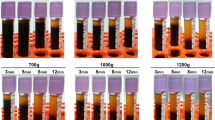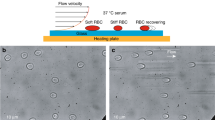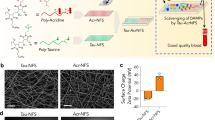Abstract
Red blood cell (RBC) hemolysis is one of the most common storage lesions in packed RBCs (pRBC). Older units of pRBCs, especially those > 21 days old, have increasing levels of hemolysis leading to increased oxidative stress and premature platelet activation. This effect can mostly be attributed to the increase of cell-free hemoglobin (Hb). Therefore, removal of cell-free Hb from pRBCs prior to transfusion could mitigate these deleterious effects. We propose a new method for the removal of Hb from pRBCs using zinc beads. Prepared Hb solutions and pRBCs were treated with zinc beads using two different protocols. UV–Vis spectrophotometry was used to determine Hb concentrations, before and after treatment. Experiments were run in triplicate and paired t tests were used to determine significant differences between groups. Zinc beads removed on average 94% of cell-free Hb within 15 min and 78% Hb from pRBCs (p < 0.0001), demonstrating a maximum binding capacity ~ 66.2 ± 0.7 mg Hb/mL beads. No differences in RBC morphology or deformability were observed after treatment. This study demonstrates the feasibility of using zinc beads for the rapid and targeted removal of Hb from pRBC units. Further investigation is needed to scale this method for large volume removal.







Similar content being viewed by others
References
Aliyu, Z. Y., A. R. Tumblin, and G. J. Kato. Current therapy of sickle cell disease. Haematologica 91:7–10, 2006.
Belanger, A. M., C. Keggi, T. Kanias, M. T. Gladwin, and D. B. Kim-Shapiro. Effects of nitric oxide and its congeners on sickle red blood cell deformability. Transfusion 55:2464–2472, 2015.
Bennett-Guerrero, E., B. S. Kirby, H. Zhu, A. E. Herman, N. Bandarenko, and T. J. McMahon. Randomized study of washing 40- to 42-day-stored red blood cells. Transfusion 54:2544–2552, 2014.
Blood Product Administration. Blood Transfusion. Washington, DC: NCLEX RN Mastery, 2019.
Chung, K. W., S. V. Basavaraju, Y. Mu, K. L. van Santen, K. A. Haass, R. Henry, J. Berger, and M. J. Kuehnert. Declining blood collection and utilization in the United States. Transfusion 56:2184–2192, 2016.
CytoSorb. Broad cytokine and toxin reduction to control deadly inflammation CytoSorbents.com. New York: CytoSorbents, 2018.
D’Alessandro, A., G. Liumbruno, G. Grazzini, and L. Zolla. Red blood cell storage: the story so far. Blood Transfusion 8:82–88, 2010.
Donadee, C., N. J. Raat, T. Kanias, J. Tejero, J. S. Lee, E. E. Kelley, X. Zhao, C. Liu, H. Reynolds, I. Azarov, S. Frizzell, E. M. Meyer, A. D. Donnenberg, L. Qu, D. Triulzi, D. B. Kim-Shapiro, and M. T. Gladwin. Nitric oxide scavenging by red blood cell microparticles and cell-free hemoglobin as a mechanism for the red cell storage lesion. Circulation 124:465–476, 2011.
Flegel, W. A., C. Natanson, and H. G. Klein. Does prolonged storage of red blood cells cause harm? Br J Haematol 165:3–16, 2014.
Glynn, S. A., H. G. Klein, and P. M. Ness. The red blood cell storage lesion: the end of the beginning. Transfusion 56:1462–1468, 2016.
Hansen, A. L., T. R. Turner, J. D. R. Kurach, and J. P. Acker. Quality of red blood cells washed using a second wash sequence on an automated cell processor. Transfusion 55:2415–2421, 2015.
Helms, C., M. Marvel, W. Zhao, M. Stahle, R. Vest, G. Kato, J. Lee, G. Christ, M. Gladwin, R. Hantgan, and D. Kim-Shapiro. Mechanisms of hemolysis-associated platelet activation. J. Thromb. Hemost. 11:2148–2154, 2013.
Huisjes, R., A. Bogdanova, W. W. van Solinge, R. M. Schiffelers, L. Kaestner, and R. van Wijk. Squeezing for life—properties of red blood cell deformability. Front Physiol 9:656, 2018.
Jensen, F. Nitric oxide formation from nitrite in zebrafish. J. Exp. Biol. 210:3387–3394, 2007.
Khanal, G., R. A. Huynh, K. Torabian, H. Xia, E. Voros, and S. S. Shevkoplyas. Towards bedside washing of stored red blood cells: a prototype of a simple apparatus based on microscale sedimentation in normal gravity. Vox Sang 113:31–39, 2018.
Kim-Shapiro, D., J. Lee, and M. Gladwin. Storage lesion: role of red cell breakdown. Transfusion 51:844–851, 2011.
Lagerberg, J. W., H. Korsten, P. F. Van Der Meer, and D. De Korte. Prevention of red cell storage lesion: a comparison of five different additive solutions. Blood Transfus. 15:456–462, 2017.
Marschner, S., and R. Goodrich. Pathogen reduction technology treatment of platelets, plasma and whole blood using riboflavin and UV light. Transfus. Med. Hemother. 38:8–18, 2011.
Osei-Hwedieh, D. O., T. Kanias, C. S. Croix, M. Jessup, Z. Xiong, D. Sinchar, J. Franks, Q. Xu, E. M. Noveli, J. T. Sertorio, K. Potoka, R. J. Binder, S. Basu, A. M. Belanger, D. B. Kim-Shapiro, D. Triulzi, J. S. Lee, and M. T. Gladwin. Sickle cell trait increases red blood cell storage hemolysis and post-transfusion clearance in mice. EBioMedicine 11:239–248, 2016.
Plum, L. M., L. Rink, and H. Haase. The essential toxin: impact of zinc on human health. Int J Environ Res Public Health 7:1342–1365, 2010.
Rifkind, J. M., and J. M. Heim. Interaction of zinc and hemoglobin: binding of zinc and the oxygen affinity. Biochemistry 16:4438–4443, 1977.
Schaer, D. J., P. W. Buehler, A. I. Alayash, J. D. Belcher, and G. M. Vercellotti. Hemolysis and free hemoglobin revisited: exploring hemoglobin and hemin scavengers as a novel class of therapeutic proteins. Blood 121:1276–1284, 2013.
Schmidt, A., M. Refaai, S. Kirkley, and N. Blumberg. Proven and potential clinical benefits of washing red blood cells before transfusion: current perspectives. Int. J. Clin. Transfus. Med. 4:79–88, 2016.
Simms, K., N. Wajih, J. Cardenas, D. B. Kim-Shapiro, and E. Rahbar. Studies of in vitro hemolysis-induced platelet activation in co-transfused packed red blood cells and platelets, 2018 (submitted).
Singhal, R., G. K. Annarapu, A. Pandey, S. Chawla, A. Ojha, A. Gupta, M. A. Cruz, T. Seth, and P. Guchhait. Hemoglobin interaction with GP1b alpha induces platelet activation and apoptosis: a novel mechanism associated with intravascular hemolysis. Haematologica 100:1526–1533, 2015.
United States Environmental Protection Agency, Clement International Corporation, Syracuse Research Corporation, and United States Agency for toxic substances and disease registry. Toxicological Profile for Zinc. Atlanta, GA: U.S. Department of Health and Human Services, Public Health Service, Agency for Toxic Substances and Disease Registry, p. 17, 1994.
Van Reen, R. Zinc Toxicity in Man and Experimental Species. Bethesda: Naval Medical Research Center, p. 18, 2019.
Warner, M. A., I. J. Welsby, P. J. Norris, C. C. Silliman, S. Armour, E. D. Wittwer, P. J. Santrach, L. A. Meade, L. M. Liedl, C. M. Nieuwenkamp, B. Douthit, C. M. van Buskirk, P. J. Schulte, R. E. Carter, and D. J. Kor. Point-of-care washing of allogeneic red blood cells for the prevention of transfusion-related respiratory complications (WAR-PRC): a protocol for a multicenter randomised clinical trial in patients undergoing cardiac surgery. BMJ Open 7:e016398, 2017.
Which agarose (sepharose) to choose? 2, 4, or 6%? Crosslinked? In: A Discussion of Protein Research G Biosciences, 2014.
Zinc chelating resin (cat. # 786-287). edited by G-Biosciences, 2018.
Zinc, Serum Online. Mayo Foundation for Medical Education and Research Please provide complete details of references [30, 31] if possible.
Acknowledgments
Funding for this study was provided by the National Science Foundation (NSF) REU Site: Imaging and Mechanics-based Projects on Accidental Cases of Trauma Impact, Award No. 1559700 (E. Rebholz summer REU intern), and National Institutes of Health (NIH). Specifically, NIH Subcontract (NIH U01 HL077863-11, Subaward No. 0010612B, Subcontract PI: E. Rahbar) and NIH Grant R01 HL098032 (D. Kim-Shapiro). Dr. Rahbar’s startup funds were also used to support this study.
Conflict of interest
No benefits in any form have been or will be received from a commercial party related directly or indirectly to the subject of this manuscript.
Author information
Authors and Affiliations
Corresponding author
Additional information
Associate Editor Dan Elson oversaw the review of this article.
Publisher's Note
Springer Nature remains neutral with regard to jurisdictional claims in published maps and institutional affiliations.
Electronic supplementary material
Below is the link to the electronic supplementary material.
Rights and permissions
About this article
Cite this article
Simms, K., Rebholz, E., Mayberry, R.M. et al. Development of Zinc Chelating Resin Polymer Beads for the Removal of Cell-Free Hemoglobin. Ann Biomed Eng 47, 1470–1478 (2019). https://doi.org/10.1007/s10439-019-02249-6
Received:
Accepted:
Published:
Issue Date:
DOI: https://doi.org/10.1007/s10439-019-02249-6




